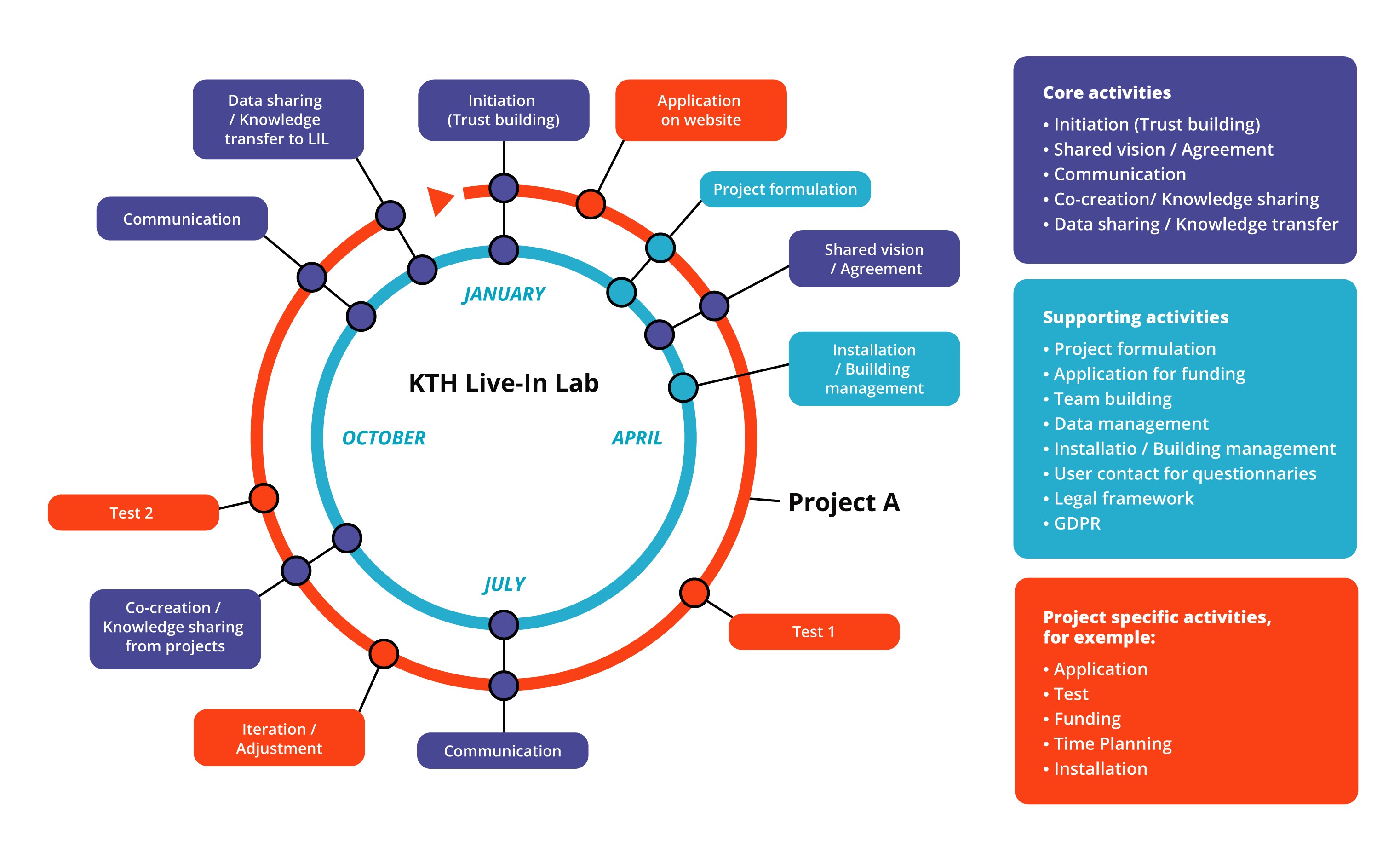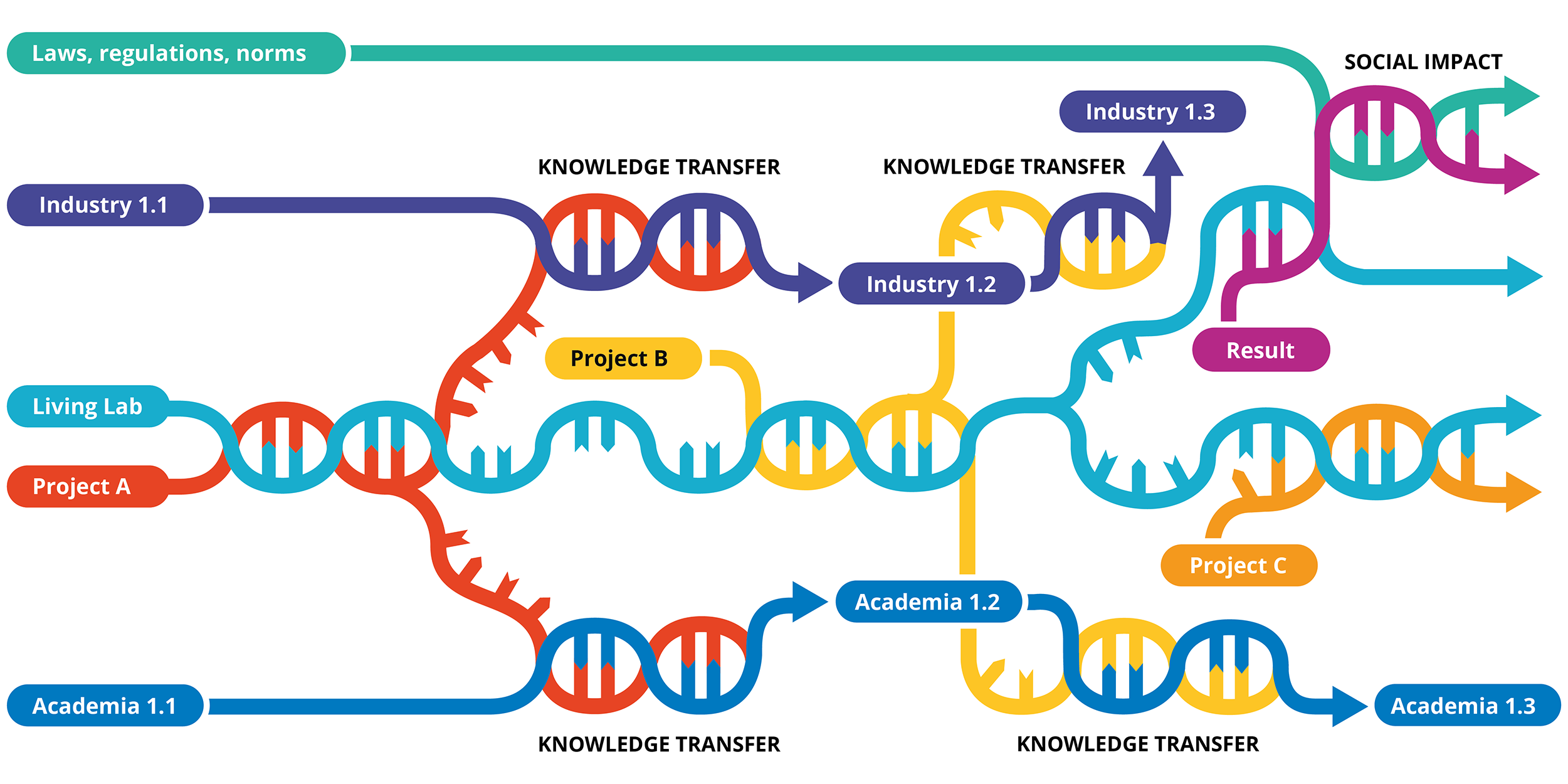Project process at KTH Live-In Lab
Use the testbeds in KTH Live-In Lab for innovative environmental technology – for research, development or education. We offer workplaces, space for necessary installations and the infrastructure and context needed for research and development of technology in a real residential environment.

Collaboration and projects in KTH Live-In Lab step by step
Step 1: Initiation (Innovation Fika): Contact is established between companies / researchers and KTH Live-In Lab. After this, an application must be submitted for further collaboration.
Step 2: Site visit / Workshop: If the application is granted companies / researchers will make a site visit to discuss different forms of collaboration, with the application as a starting point.
Step 3: Collaboration: Collaboration between researchers / companies and KTH Live-In Lab is formulated and formalized. The collaboration can happen on different levels:
- Project collaboration: Companies and researchers use the testbeds for research and postgraduate education; basic education; assignment research or assignment training. Companies and / or researchers proceed with a project description including budget and agreement. Project collaboration can take various forms, for example:
- Industrial PhD student project (approx. 50,000 sek / year to KTH Live-In Lab in addition to supervision and normal infrastructure according to specific budget).
- Assignment research projects and assignment training (cost coverage according to specific budget).
- Research projects, typically externally funded through e.g. VINNOVA, Formas, EU el. like. (approx. 50,000 - 200,000 sek / year to KTH Live-In Lab according to specific budget).
- Letter of Intent: Small companies, start ups or researchers can obtain a "Letter of Intent" with the aim of facilitating project collaboration, if their idea, product or service is considered relevant to KTH Live-In Lab.
- Strategic collaboration: Companies may also want to collaborate with KTH Live-In Lab at a strategic level, outside the scope of the application. The purpose of a strategic partnership is to create collaboration between KTH and the business community.
Strategic partners are involved in undergraduate, research and / or postgraduate education. The instrument for collaboration is KTH Live-In Labs Innovation Council (see value offers). Companies' commitment to strategic cooperation is recorded as a contribution. A contract is signed with the research donor and KTH requests the funds according to the contract.
Step 4: Project bussiness: The project proceeds in accordance with an agreement. The project handles everything from tests to report writing, but KTH Live-In Lab can help if needed.
Step 5: Communication and reports : Twice a year, the project shall provide information that is posted on KTH Live-In Lab's website, this is done in collaboration with KTH Live-In Lab. The template for communication material is obtained from KTH Live-In Lab. When the project is finished, a final report has to be written. If a repport should already be done within the framework of e.g. VINNOVA or Formas, no further report is needed.
Step 6: Data storage and results : When the project is finished, the results and data shall also be stored in KTH Live-In Lab´s database. This is in order for future projects to be able to take on and further develop thoughts and ideas.

Cost for projects in KTH Live-In Lab
KTH Live-In Lab has an annual cost for infrastructure and personnel to be covered. KTH Live-In Lab should not make a profit, which means that all projects implemented in KTH Live-In Lab shall contribute to cover the annual costs. The basic principle is,
- Students and small research projects don´t pay anything.
- Courses pay for the hours/resources used.
- In the case of large projects, KTH Live-In Lab is happy to assist in writing the application, and an expense item such as infrastructure or personnel.
- Industrial projects pays between 50 00 - 200 000 sek/år to KTH Live-In Lab, in addition to the project specific costs för installation/remodeling etc. The annual fee is determined based on the resources required by the project, from only data to major remodeling and it shall cover the time that KTH Live-In Lab puts down on managing the project.
The annual test cycle
Research, development and teaching associated with KTH Live-In Lab follows the academic year. Projects can start any time of the year, but often some rebuilding is required for new projects. Projects usually last for 10 months, but may be longer or shorter depending on needs and budget.
The project does not end on completion of the study – it is also important to communicate the results. KTH Live-In Lab can assist in doing this. The strategy for publishing is designed in collaboration with project partners and KTH. The annual conferences and workshops within the framework of the Innovation Council are opportunities to present results.
